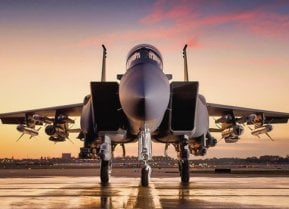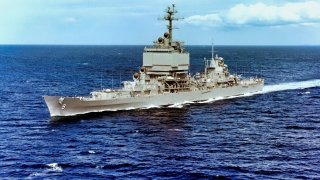USS Long Beach: The U.S. Navy Had a Massive Nuclear-Powered Cruiser
Although the USS Long Beach was intended to remain in the service for decades after being upgraded with the Aegis Combat System, the ship’s life was cut short.
Perhaps the most recognizable Cold War ship is the USS Long Beach (CGN-9).
As the U.S. Navy’s first-ever nuclear-powered surface combatant, this formidable vessel resembled no other ship the world had ever seen before.
Her predecessor cruisers were completions or conversions of ships begun or completed during the Second World War, making the USS Long Beach the sole “all new” cruiser to be fully designed and produced post war.
Introducing the USS Long Beach
The third Navy vessel named to honor the city of Long Beach, California, the USS Long Beach would also be referred to by sailors as the “Only Real Cruiser” in her later years.
The cruiser was initially ordered as CLGN-160 but was reclassified twice throughout her history.
The USS Long Beach was first reclassified as CGN-160 in early 1957 and was eventually reclassified again as CGN-9 the same year.
Manufacturers Bethlehem Steel Co., Fore River Shipyard in Quincy, Massachusetts laid down her keel in late 1957. When the USS Long Beach was commissioned a few years later, the hefty ship had a reported price tag of roughly $320 million ($over $3 billion today).
Although the USS Long Beach was designed as an “all missile” ship from the start, she was also constructed with two gun mounts amidships at President John F. Kenney’s order.
The cruiser was also the last of her kind to be built on a traditional lean and long cruiser hull.
Over time, new cruisers would represent converted frigates, including the USS Leahy, USS Bainbridge, USS Truxtun, USS Belknap and both California and Virginia-classes.
The Long Beach was also built to be slated for the Regulus nuclear cruise missile, which would later be replaced with the four launching tubes required for the Polaris missile.
The USS Long Beach- specs and capabilities:
As detailed by Seaforces, the USS Long Beach was powered by two nuclear reactors, enabling the ship to travel at speeds up to 30 knots. The boat was also incorporated with the SCANFAR system, including the AN/SPS-32 and AN/SPS-33 phased array radars. The installation of these radars onto the USS Long Beach demonstrated how she was an experimental platform for these radars and was therefore a single-class ship.
Down the line, the new AN/SPY-1 phased array systems would be installed onto the Ticonderoga-class cruisers and Arleigh Burke-class destroyers. On her fantail, the Long Beach was fitted with the Talos missile system. Measuring about the size of a telephone pole, these potentially nuclear-armed missiles would linger on the launch rail, building up thrust before take off.
An overview of USS Long Beach’s operational history
When the Long Beach was first commissioned, she was assigned to the Atlantic Fleet and was homeported at Norfolk, VA.
Within a few years, she trained in the Caribbean and sailed to join the 6thFleet in its Mediterranean peacekeeping operations.
By the end of 1967, the Long Beach would join the attack carrier USS Enterprise and guided missile frigate USS Bainbridge in forming the first ever all-nuclear-powered task group.
This notable sail demonstrated the prowess of the Navy’s growing nuclear-powered arsenal. Like many of her sister ships, the Long Beach would participate in the Vietnam War. The ship’s tour of duty in the West Pac was centered primarily on PIRAZ station.
In 1980, Long Beach carried out one of its more recognizable missions when she rescued 114 Vietnamese boat people off the coast of Vietnam. In the same year, the ship sailed back to the U.S., where she would undergo a considerable overhaul.
Long Beach saw the removal of her SCANFAR system and the installation of enhanced flagship facilities in addition to modern radars like the AN/SPS-48.
By the end of the decade, the Long Beach would also be fitted with the BGM-109 Tomahawk cruise missile system, in addition to the 4-cell Armored Box Launchers on the fantail.
What happened to the USS Long Beach?
Although the USS Long Beach was intended to remain in the service for decades after being upgraded with the Aegis Combat System, the ship’s life was cut short.
Due to budget constraints following the 1991 Gulf War, the Navy decided to nix its inventory of nuclear cruisers as their reactor cores diminished.
A formal deactivation ceremony for the Long Beach occurred in 1994 at Norfolk Naval Station.
Today, the ship’s hull and reactor compartments remain in storage at the Puget Sound Naval Shipyard in Bremerton, Washington.
Maya Carlin is an analyst with the Center for Security Policy and a former Anna Sobol Levy Fellow at IDC Herzliya in Israel. She has by-lines in many publications, including The National Interest, Jerusalem Post, and Times of Israel. You can follow her on Twitter: @MayaCarlin.
Image Credit: Creative Commons.


